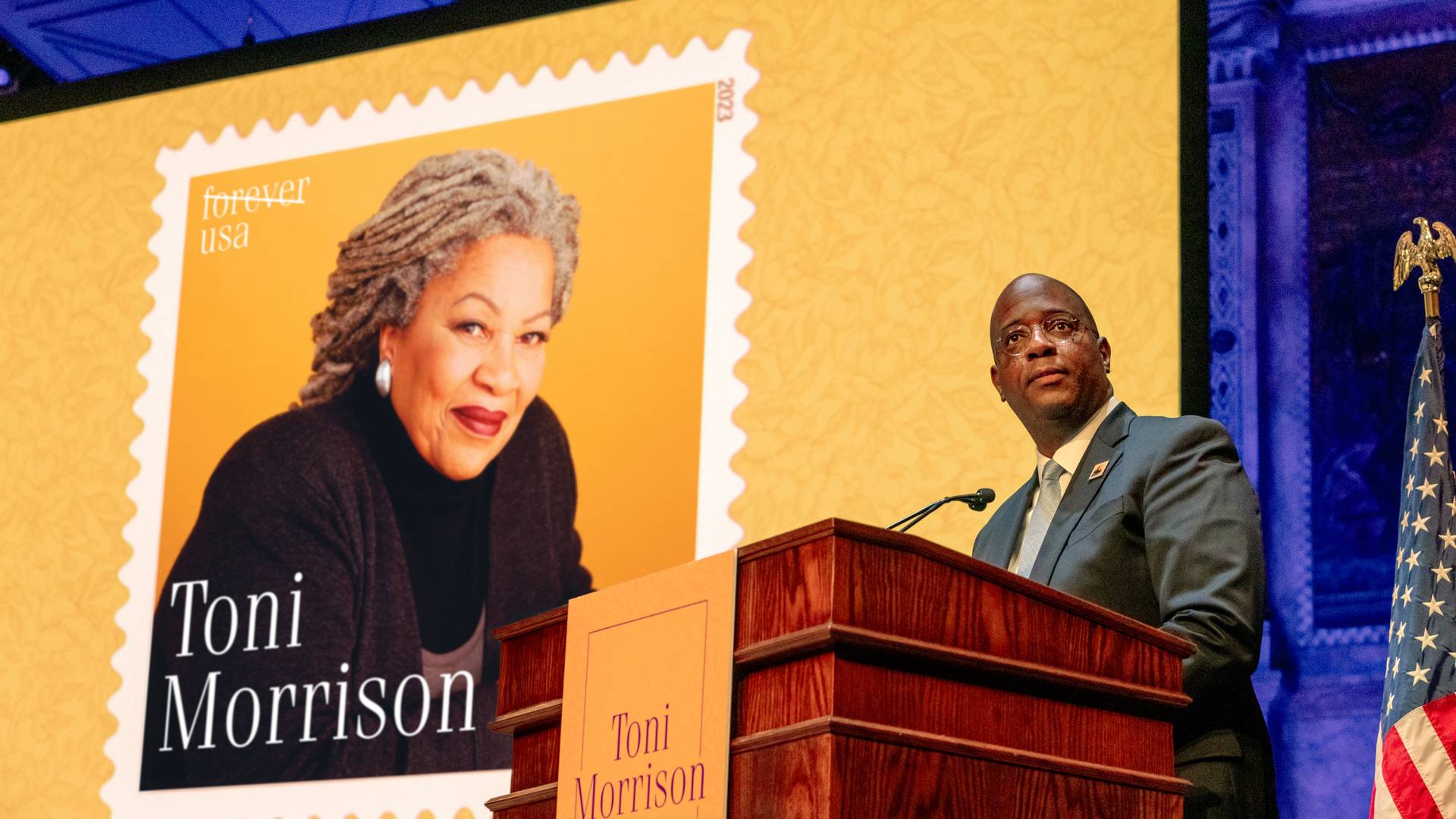Dean of the Faculty Gene Jarrett, Class of 1997, honors his former professor Toni Morrison with a speech at the March 7 dedication ceremony for the Toni Morrison Forever U.S. postage stamp.
“Stamp Paid” is the nickname of a minor yet meaningful character in Toni Morrison’s 1987 novel, "Beloved." Born Joshua, he renamed himself after he concluded that only benevolence could pay his moral debt to the world. In the years before the Civil War, whether by road or by river, he shepherded runaways from slavery to freedom. Besides this Underground Railroad, Stamp Paid took to heart his motto that “You paid it; now life owes you” by protecting slaves in yet another way. “Whole families lived on the bones and guts he distributed to them,” the novel says. “He wrote their letters and read to them the ones they received.”
When Toni Morrison first published these lines 36 years ago in her Pulitzer Prize-winning novel, she captured how letters on pages could open the minds of the enslaved to the promise of franchise and freedom; how letters in envelopes could link the friends and families whose bonds slavery had torn asunder; and how the lettered, or those who fought against all odds to learn how to read, could build a sense of moral purpose to secure a more humane future when their liberty could thrive unfettered and when their rights as citizens could prosper.
Featuring Toni Morrison on a United States stamp today, of course, attests to how far we have come in valuing the diversity of contributions to American life and culture. In 1847, when a five-cent postage stamp bore the portrait of Benjamin Franklin and a ten-cent stamp showed the portrait of George Washington, we were entering a 19th-century chapter of national iconography: This chapter featured such Founding Fathers as Franklin, Washington and Thomas Jefferson, and, later, such presidents as Abraham Lincoln and Ulysses S. Grant.
Not until well into the 20th century, such as in the 1940 series of Famous Americans, the 1965 series of Prominent Americans, and the 1980 series of Great Americans, could we enjoy an expanded commemoration of national citizens on U.S. stamps to include women, African Americans, Native Americans and Asian Americans.
Today, we can finally extol a canonical lineage of African American women writers who have appeared on U.S. stamps: Ida B. Wells in 1990, Zora Neale Hurston in 2003, Anna Julia Cooper in 2009, Gwendolyn Brooks in 2012, Maya Angelou in 2015, and Nella Larsen in 2020. For Toni Morrison’s image to grace the stamp in 2023 consummates further the supreme stature her life and career have achieved in the 21st century.
Yet Toni Morrison’s own literary words caution us not to praise unwittingly the diversity of subjects in American culture, whether in literature or on the stamp, at the expense of grasping why such diversity enables America to excel as a nation among nations in the world.
In her endowed lectures at the University of Michigan in 1988 and at Harvard in 1990, both of which informed her classic 1992 book "Playing in the Dark," Toni Morrison asserted that the lives of African Americans — both their ancestors and descendants — not only enriched our scope of American history; these lives widened our appreciation of what it means to be an “American.”
By circulating more than 3,000 images during close to two centuries, the U.S. stamp has been one of the most prominent devices to link us to one another in this country and across the globe — whether literally, through postal mail, or symbolically, through national iconography. While Toni Morrison’s image on the stamp welcomes us as consumers, the legacy of her intellect, of her artistry, welcomes us as thinkers: we must ensure that the story of democracy and national citizenship, told across generations by the U.S. stamp, culminates with a resolutely inclusive idea of what it means to be an American. This nation demonstrates its greatest cultural potential, in other words, when all its diverse array of talent is included — that is, embraced and enhanced — for the greater good.
Toni Morrison is one of the most accomplished and distinguished faculty members ever to grace the campuses of higher education — from Howard University to Princeton University. The Nobel laureate and renowned professor enlightened scores of former students, including myself, but also teachers and readers around the world, to the timeless insight of literature to the history and complexity of the human condition.
Today, we celebrate her image on the U.S. stamp not merely for what her image represents in the story of national progress. This occasion reminds us of the remarkable American story in which Stamp Paid, any way he could, reckoned with owing a moral debt to his society. Indeed, it was that very American story to which Toni Morrison devoted her literature, until the very end, so that we could better comprehend our own life and times.






